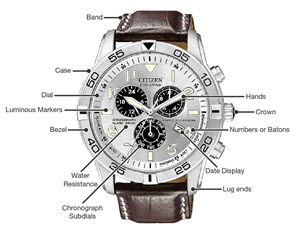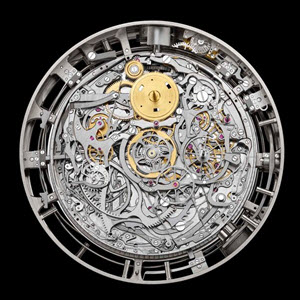What are the Parts and Typical Anatomy of Watches?

Anatomy and Parts of a Watch
The Parts of a Wrist WatchAlthough there is a huge variety of different companies most watches are built with the same types of parts. Lets look at the insides to see how they work, but we won't worry about which watch brand it is.
Not all watches are equal and there are definitely exceptions to any rule, but the anatomy of a watch is usually similar enough that which particular brand we look at won't matter. So take out your timepiece and look for the parts on your own watch.
Case
The most important part of the watch could very well be the most basic and simple part of it, the case. Without this durable outer layer to hold the vital mechanical parts inside safe and sound, how long would your chronometer last? The case can come in a variety of shapes and sizes. The most common shape is round and watch makers even say that it is cheaper to replace a broken faceplate that is round.
It can also be made from a large variety of materials, which can greatly change the price to purchase the watch. From Ceramic or wood to Gold or Platinum there is a type for anyone. I personally like the stainless steel which is extremely durable and doesn't cost a small fortune like Platinum.
Crystal
While some of the early made watches used glass to cover the face of the watch, people found that glass breaks often and watchmakers started looking for other materials use. Craftsmen started using mineral crystals, which are pretty much glass with a little better scratch resistance. Swiss watch makers love to use synthetic sapphire since it is almost as hard as diamond, but it comes with a higher price than just glass.
With the invention of quartz time pieces and plastics the watch industry started searching for something less expensive than sapphire, but stronger than glass. Acrylic fits this description and can also be made into any shape, though they are prone to scratching.
Dial

Inside of a Watch Movement Anatomy
The main function of a watch is to tell us the time and what watch anatomy would be complete without a description of the dial? Some newer digital watches don't even have a dial since they display numbers, but most watches have a dial with hands for time keeping.
The basic dial has just stick markers without a numeral indicator to read. Surprisingly Roman dials are still used and can be both Roman or Roman and Stick dials. Then there is the Arabic dial for those of us that need the numbers written out. California even has a dial that consists of both Arabic, Roman, and Stick, but any dial will work as long as the wearer can read what time it is.
The dial can also have a window or aperture that can display other important information. Usually the window is used for displaying the date, but some watches have multiple windows with each one displaying some bit of useful information. The most common type of buckle is the Ardillon buckle, which uses buckle and pin to hold the watch in place. Later a new Deployant buckle was designed with a special clasping mechanism on the buckle. This allowed the watch to stay on the wearers wrist even if it opened up.
Hands
The hands on a watch are the means for us to read what time it is and as with the dial some modern digital watches have done away with them. Like all the other parts of a watch the hands can come in a variety of materials and shapes. Some watches have the seconds hand and I have even seen a watch with only an hour hand. Most watches have a minutes hand and an hour hand though.
The biggest advancement in watch hand technology occurred in the 19th century when a watchmaker heated the steel of the hands up to turn them a dark blue. He thought it made it easier to read the watch and people agreed with him making "blued steel" hands a success. Craftsmen later added luminescent material to make the hands even easier to read and some watches even have a light so you can read the watch in absolute darkness.
Buckles
The major difference between a pocket watch and a wrist watch is the buckle. Once people started wearing wrist watches the buckle became a major part of the watch. Not only does it add to the aesthetic of the watch, but it holds the watch in place. From alligator skin to stainless steel you can find watches with a variety of materials used for the buckle, but most watches use one of these two types of buckles.
Not all watches are made of the same materials, but they often have the same parts. Beyond the buckle, hands, dial, case and crystal are the mechanical insides of a watch. The watchmakers also have added a bevy of different options beyond the basic watch.
Bezels, water resistance, shock resistance and even helium escape valves are parts of some modern watches. All these extras are just extras though and it is the time telling ablility of watches that keep us looking at our wrists and asking, 'what time is it'?
